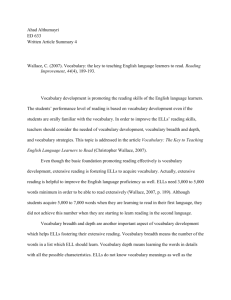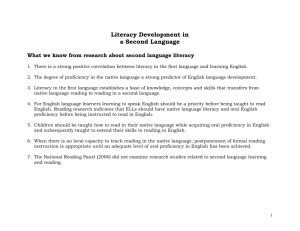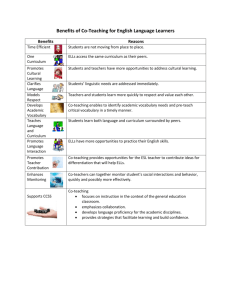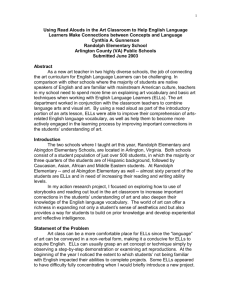2015 Listening & Speaking PLD Primary Rater
advertisement
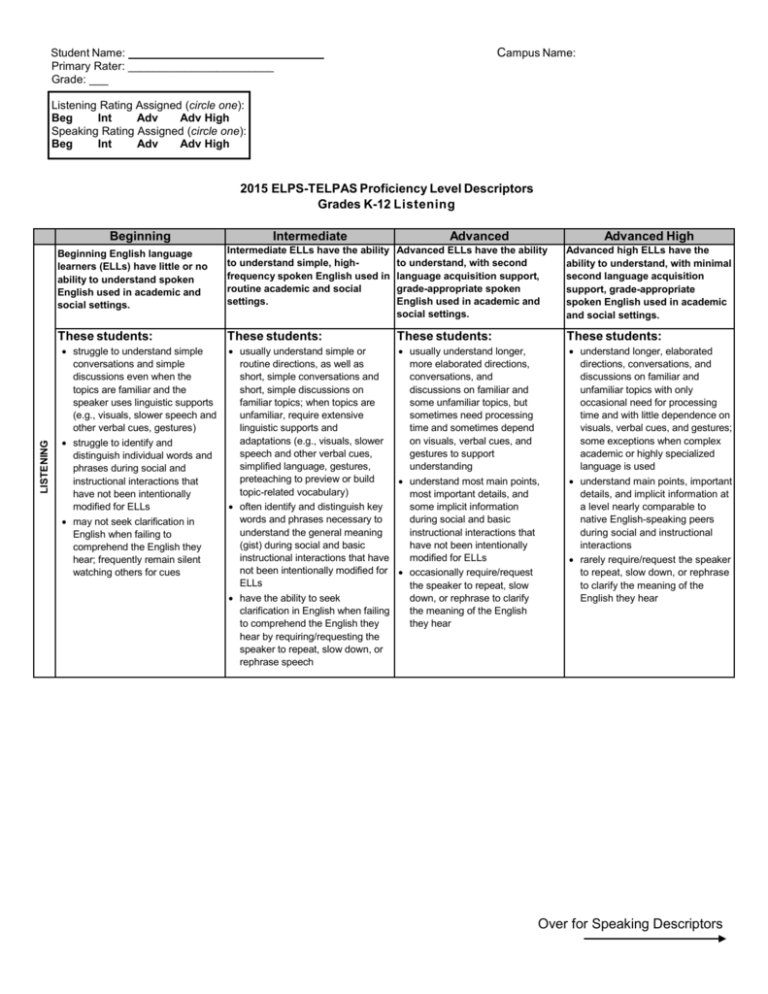
Campus Name: Student Name: _______________________________ Primary Rater: _______________________ Grade: ___ Listening Rating Assigned (circle one): Beg Int Adv Adv High Speaking Rating Assigned (circle one): Beg Int Adv Adv High 2015 ELPS-TELPAS Proficiency Level Descriptors Grades K-12 Listening LISTENING Beginning Intermediate Advanced Advanced High Beginning English language learners (ELLs) have little or no ability to understand spoken English used in academic and social settings. Intermediate ELLs have the ability to understand simple, highfrequency spoken English used in routine academic and social settings. Advanced ELLs have the ability to understand, with second language acquisition support, grade-appropriate spoken English used in academic and social settings. Advanced high ELLs have the ability to understand, with minimal second language acquisition support, grade-appropriate spoken English used in academic and social settings. These students: These students: These students: These students: struggle to understand simple conversations and simple discussions even when the topics are familiar and the speaker uses linguistic supports (e.g., visuals, slower speech and other verbal cues, gestures) struggle to identify and distinguish individual words and phrases during social and instructional interactions that have not been intentionally modified for ELLs may not seek clarification in English when failing to comprehend the English they hear; frequently remain silent watching others for cues usually understand simple or usually understand longer, routine directions, as well as more elaborated directions, short, simple conversations and conversations, and short, simple discussions on discussions on familiar and familiar topics; when topics are some unfamiliar topics, but unfamiliar, require extensive sometimes need processing linguistic supports and time and sometimes depend adaptations (e.g., visuals, slower on visuals, verbal cues, and speech and other verbal cues, gestures to support simplified language, gestures, understanding preteaching to preview or build understand most main points, topic-related vocabulary) most important details, and often identify and distinguish key some implicit information words and phrases necessary to during social and basic understand the general meaning instructional interactions that (gist) during social and basic have not been intentionally instructional interactions that have modified for ELLs not been intentionally modified for occasionally require/request ELLs the speaker to repeat, slow have the ability to seek down, or rephrase to clarify clarification in English when failing the meaning of the English to comprehend the English they they hear hear by requiring/requesting the speaker to repeat, slow down, or rephrase speech understand longer, elaborated directions, conversations, and discussions on familiar and unfamiliar topics with only occasional need for processing time and with little dependence on visuals, verbal cues, and gestures; some exceptions when complex academic or highly specialized language is used understand main points, important details, and implicit information at a level nearly comparable to native English-speaking peers during social and instructional interactions rarely require/request the speaker to repeat, slow down, or rephrase to clarify the meaning of the English they hear Over for Speaking Descriptors 2015 ELPS-TELPAS Proficiency Level Descriptors Grades K-12 Speaking SPEAKING Beginning Intermediate Advanced Advanced High Beginning English language learners (ELLs) have little or no ability to speak English in academic and social settings. Intermediate ELLs have the ability to speak in a simple manner using English commonly heard in routine academic and social settings. Advanced ELLs have the ability to speak using gradeappropriate English, with second language acquisition support, in academic and social settings. Advanced high ELLs have the ability to speaking using gradeappropriate English, with minimal second language acquisition support, in academic and social settings. These students: These students: These students: These students: are able to express simple, original messages, speak using sentences, and participate in short conversations and classroom interactions; may hesitate frequently and for long periods to think about how to communicate desired meaning speak simply using basic vocabulary needed in everyday social interactions and routine academic contexts; rarely have vocabulary to speak in detail exhibit an emerging awareness of English grammar and speak using mostly simple sentence structures and simple tenses; are most comfortable speaking in present tense exhibit second language acquisition errors that may hinder overall communication when trying to use complex or less familiar English use pronunciation that can usually be understood by people accustomed to interacting with ELLs are able to participate comfortably in most conversations and academic discussions on familiar topics, with some pauses to restate, repeat, or search for words and phrases to clarify meaning discuss familiar academic topics using content-based terms and common abstract vocabulary; can usually speak in some detail on familiar topics have a grasp of basic grammar features, including a basic ability to narrate and describe in present, past, and future tenses; have an emerging ability to use complex sentences and complex grammar features make errors that interfere somewhat with communication when using complex grammar structures, long sentences, and less familiar words and expressions may mispronounce words, but use pronunciation that can usually be understood by people not accustomed to interacting with ELLs are able to participate in extended discussions on a variety of social and grade-appropriate academic topics with only occasional disruptions, hesitations, or pauses communicate effectively using abstract and content-based vocabulary during classroom instructional tasks, with some exceptions when low-frequency or academically demanding vocabulary is needed; use many of the same idioms and colloquialisms as their native English-speaking peers can use English grammar structures and complex sentences to narrate and describe at a level nearly comparable to native English-speaking peers make few second language acquisitions errors that interfere with overall communication may mispronounce words, but rarely use pronunciation that interferes with overall communication mainly speak using single words and short phrases consisting of recently practiced, memorized, or highly familiar material to get immediate needs met; may be hesitant to speak and often given up in their attempts to communicate speak using a very limited bank of high-frequency, high-need, concrete vocabulary, including key words and expressions needed for basic communication in academic and social contexts lack the knowledge of English grammar necessary to connect ideas and speak in sentences; can sometimes produce sentences using recently practiced, memorized, or highly familiar material exhibit second language acquisition errors that may hinder overall communication, particularly when trying to convey information beyond memorized, practiced, or highly familiar material typically use pronunciation that significantly inhibits communication


